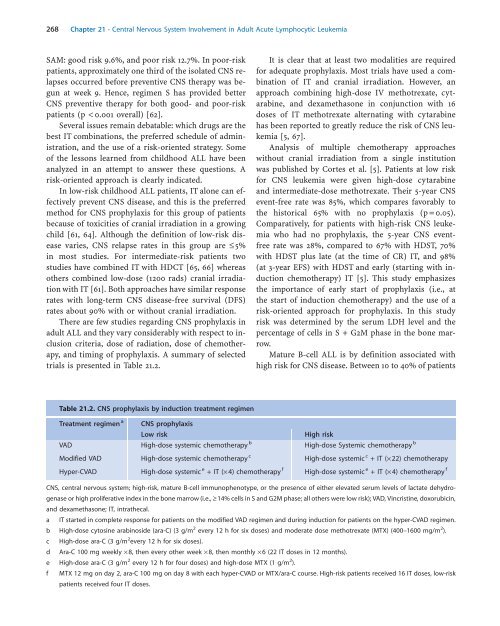Acute Leukemias - Republican Scientific Medical Library
Acute Leukemias - Republican Scientific Medical Library
Acute Leukemias - Republican Scientific Medical Library
Create successful ePaper yourself
Turn your PDF publications into a flip-book with our unique Google optimized e-Paper software.
268 Chapter 21 · Central Nervous System Involvement in Adult <strong>Acute</strong> Lymphocytic Leukemia<br />
SAM: good risk 9.6%, and poor risk 12.7%. In poor-risk<br />
patients, approximately one third of the isolated CNS relapses<br />
occurred before preventive CNS therapy was begun<br />
at week 9. Hence, regimen S has provided better<br />
CNS preventive therapy for both good- and poor-risk<br />
patients (p < 0.001 overall) [62].<br />
Several issues remain debatable: which drugs are the<br />
best IT combinations, the preferred schedule of administration,<br />
and the use of a risk-oriented strategy. Some<br />
of the lessons learned from childhood ALL have been<br />
analyzed in an attempt to answer these questions. A<br />
risk-oriented approach is clearly indicated.<br />
In low-risk childhood ALL patients, IT alone can effectively<br />
prevent CNS disease, and this is the preferred<br />
method for CNS prophylaxis for this group of patients<br />
because of toxicities of cranial irradiation in a growing<br />
child [61, 64]. Although the definition of low-risk disease<br />
varies, CNS relapse rates in this group are £5%<br />
in most studies. For intermediate-risk patients two<br />
studies have combined IT with HDCT [65, 66] whereas<br />
others combined low-dose (1200 rads) cranial irradiation<br />
with IT [61]. Both approaches have similar response<br />
rates with long-term CNS disease-free survival (DFS)<br />
rates about 90% with or without cranial irradiation.<br />
There are few studies regarding CNS prophylaxis in<br />
adult ALL and they vary considerably with respect to inclusion<br />
criteria, dose of radiation, dose of chemotherapy,<br />
and timing of prophylaxis. A summary of selected<br />
trials is presented in Table 21.2.<br />
Table 21.2. CNS prophylaxis by induction treatment regimen<br />
It is clear that at least two modalities are required<br />
for adequate prophylaxis. Most trials have used a combination<br />
of IT and cranial irradiation. However, an<br />
approach combining high-dose IV methotrexate, cytarabine,<br />
and dexamethasone in conjunction with 16<br />
doses of IT methotrexate alternating with cytarabine<br />
has been reported to greatly reduce the risk of CNS leukemia<br />
[5, 67].<br />
Analysis of multiple chemotherapy approaches<br />
without cranial irradiation from a single institution<br />
was published by Cortes et al. [5]. Patients at low risk<br />
for CNS leukemia were given high-dose cytarabine<br />
and intermediate-dose methotrexate. Their 5-year CNS<br />
event-free rate was 85%, which compares favorably to<br />
the historical 65% with no prophylaxis (p = 0.05).<br />
Comparatively, for patients with high-risk CNS leukemia<br />
who had no prophylaxis, the 5-year CNS eventfree<br />
rate was 28%, compared to 67% with HDST, 70%<br />
with HDST plus late (at the time of CR) IT, and 98%<br />
(at 3-year EFS) with HDST and early (starting with induction<br />
chemotherapy) IT [5]. This study emphasizes<br />
the importance of early start of prophylaxis (i.e., at<br />
the start of induction chemotherapy) and the use of a<br />
risk-oriented approach for prophylaxis. In this study<br />
risk was determined by the serum LDH level and the<br />
percentage of cells in S + G2M phase in the bone marrow.<br />
Mature B-cell ALL is by definition associated with<br />
high risk for CNS disease. Between 10 to 40% of patients<br />
Treatment regimen a<br />
CNS prophylaxis<br />
Low risk High risk<br />
VAD High-dose systemic chemotherapy b<br />
High-dose Systemic chemotherapy b<br />
Modified VAD High-dose systemic chemotherapy c<br />
Hyper-CVAD High-dose systemic e +IT(´ 4) chemotherapy f<br />
High-dose systemic c +IT(´22) chemotherapy<br />
High-dose systemic e +IT(´ 4) chemotherapy f<br />
CNS, central nervous system; high-risk, mature B-cell immunophenotype, or the presence of either elevated serum levels of lactate dehydrogenase<br />
or high proliferative index in the bone marrow (i.e., ³ 14% cells in S and G2M phase; all others were low risk); VAD, Vincristine, doxorubicin,<br />
and dexamethasone; IT, intrathecal.<br />
a IT started in complete response for patients on the modified VAD regimen and during induction for patients on the hyper-CVAD regimen.<br />
b High-dose cytosine arabinoside (ara-C) (3 g/m 2 every 12 h for six doses) and moderate dose methotrexate (MTX) (400–1600 mg/m 2 ).<br />
c High-dose ara-C (3 g/m 2 every 12 h for six doses).<br />
d Ara-C 100 mg weekly ´ 8, then every other week ´ 8, then monthly ´ 6 (22 IT doses in 12 months).<br />
e High-dose ara-C (3 g/m 2 every 12 h for four doses) and high-dose MTX (1 g/m 2 ).<br />
f MTX 12 mg on day 2, ara-C 100 mg on day 8 with each hyper-CVAD or MTX/ara-C course. High-risk patients received 16 IT doses, low-risk<br />
patients received four IT doses.
















